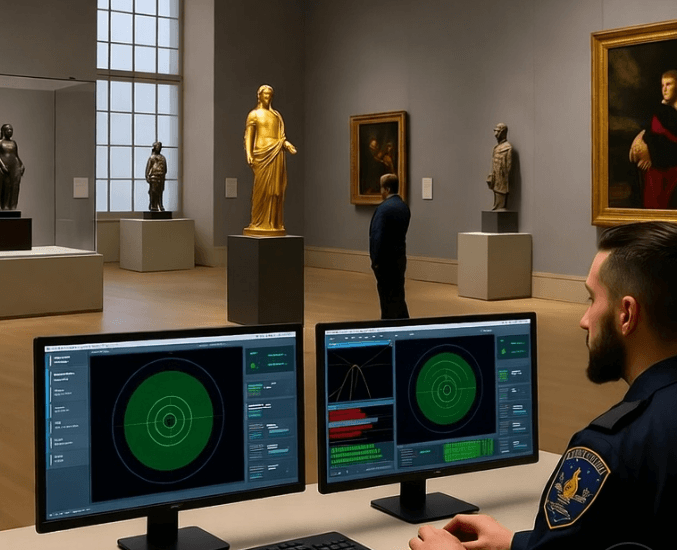LINPOWAVE is a leading provider of Millimeter-Wave Radar solutions, specializing in high-precision sensing for security and smart city applications.
A daring theft unfolded at the Louvre in Paris recently, where intruders relied on a furniture lift from the German firm Böcker to pilfer crown jewels estimated at 88 million euros—all in under eight minutes. Weaknesses emerged clearly in the museum's safeguards, from antiquated video surveillance to overlooked boundary areas and hesitant alerts to suspicious movements. Böcker turned the unexpected attention into a clever promotion, highlighting their equipment as silent and efficient for handling valuables. While the campaign amuses some, the incident urges a closer look at protecting cultural sites in our connected world. Conventional cameras and alarms sometimes prove inadequate against clever schemes, prompting questions about better alternatives. Millimeter-wave radar, or mmWave radar, stands out as a promising, non-intrusive tool that could avert such breaches. We at LINPOWAVE draw on our hands-on work with this technology to explain its workings, roles in protection, benefits, and limitations, showing ways it strengthens defenses.
What is Millimeter-Wave Radar?
This radar employs electromagnetic signals in a narrow band—wavelengths between one and ten millimeters, frequencies ranging from 30 to 300 gigahertz—to sense surroundings. It operates much like echolocation in nature: devices send out rapid pulses, which rebound from surfaces, and analyzers interpret the echoes' timing, power, shifts in phase, and frequency alterations to map out locations, motions, contours, and compositions accurately. Such detail surpasses older microwave systems, achieving precision at the centimeter or even millimeter scale, especially useful in cluttered spaces.
Military uses pioneered it during the Second World War, yet recent progress in wireless networks and compact electronics has brought it to everyday settings. Analyses from tech observers emphasize its steadfast performance regardless of lighting, mist, storms, or haze—ideal for reliable monitoring. Safe for people with minimal emission compared to imaging rays, it sees through fabrics or partitions without intrusion. Cameras record visuals that might breach confidentiality, but this radar creates abstract data points or heat patterns, sketching forms anonymously—a boon under strict data protection like Europe's GDPR.
Pairing with smart algorithms enhances its sensing capabilities. Our 4D series at LINPOWAVE, such as V200 and U100L models, handle presence spotting and path following; free development kits allow smooth blending into current setups, complete with live views, interference checks, and object spotting. Rather than standalone units, these integrate into wider protective frameworks, boosting quickness and trustworthiness overall.
Core Applications of Millimeter-Wave Radar in Security
1. Boundary and Perimeter Protection
Boundary protection at vast locations—think art galleries, flight hubs, or detention centers—thrives with mmWave radar's broad, real-time scans for odd activities, including nearing trucks, unfolding scaffolds, or climbing individuals. Engineering studies on specific wave setups commend their form recognition with error rates below five percent. At the Louvre, the balcony access via lift might have prompted swift notifications if radar watched.
Our U300 line (tuned to 77 gigahertz with spans from close quarters to 300 meters) shifts from road oversight to edge guarding, gauging velocities precisely amid distractions like branches or creatures. American airfields, as examples, cut unauthorized entries by over thirty percent through akin tech, according to sector insights—and linking with aerial robots, using our U100L (at 60 gigahertz up to 150 meters), broadens vigilant reach dynamically.
2. Crowd Monitoring and Anomaly Detection
Monitoring groups in lively spots—exhibits, shops, transport points—profits from touchless reviews that count visitors and highlight peculiarities, be it sudden dashes, hidden gear, or teamed efforts. Health institute findings show AI-boosted radar foresees dangers by noting lingering or trailing actions. The Louvre's culprits tested their tool ahead; radar could have noted that unusual pre-incident activity.
Our devices perform well in domestic and civic roles: U100L's multidimensional handling grabs scene info instantly, assessing gaps, directions, heights to tell people from machines and ease jam-related risks. Sites with this reach ninety-five percent spot-on for odd conduct, outpacing video feeds' seventy percent, as data reveals; plus, it tracks multiple subjects, isolating risks in crowds—our no-cost kits ease AI merges for forward-thinking signals. Learn more in our 4D mmWave security applications blog.
3. Hidden Item and Concealment Checks
Hidden item checks advance in entry points, resembling body imagers at travel gates that probe attire for metals or synthetics like edges or blasts. Galleries might place this at doors or show zones to block tool concealment. Wave tech overviews stress sensitivity to small discrepancies at centimeter levels. Following the Louvre, group crime theories surfaced; radar could follow lingering signs or rebuild escapes.
Our V200 (geared for mobility yet flexible) and U100L craft data clouds with fine resolution, extending to non-metal finds beyond basic detectors. Continental frontiers note forty percent rises in seized goods.
4. Integrated Security Systems with mmWave Radar
Millimeter-wave radar excels when integrated with other security components (visual cameras, heat detectors, and smart hubs) to form a comprehensive, all-encompassing shield. This integration is vital for large-scale cultural heritage protection.
Key Integration Advantages:
-
Aesthetic and Discreet: Slim radar units are easily accommodated within heritage buildings like the Louvre without compromising aesthetics, effectively covering areas where cameras are unsuitable or restricted.
-
Instant Data Fusion: Leveraging edge computing, data fusion allows for instant analysis and breakdown, generating actionable insights such as 3D sketches from data clusters to aid security personnel.
-
Versatile Connectivity: Our port-rich, power-efficient radar designs integrate seamlessly into existing security infrastructure and smart city management systems.
-
Enhanced Coverage: Aerial options in our product range boost overhead surveillance, dynamically reinforcing ground-level monitoring efforts.
Industry forecasts predict that the mmWave security market will swell to vast sums by the decade's end, underscoring its growing role in safeguarding invaluable cultural assets.
Sophisticated types—aperture synthesis and beam shaping—extend utilities further. Technical papers detail imaging clarity for insides and outs, multi-angle sweeps for knotty areas. Our 4D advances include these, effective in confined secures like lockups or outposts, detecting past barriers or below ground—suited for gallery hideaways. Explore museum security best practices for context.
Potential Value of Millimeter-Wave Radar from the Louvre Case
Museum head Laurence des Cars acknowledged flaws in aged systems that missed initial signs. Offenders moved fast after doors opened, skirting inspections with the lift. These shortcomings—delayed reactions, hidden spots, slow countermeasures—reveal old methods' limits. MmWave radar addresses them by scouting far-off irregularities actively; swift climbs become obvious. Discreet in function, echoing the firm's "quiet as a whisper" phrase, it maintains guest comfort.
Picture the Louvre equipped with our tools: U300 scanning exteriors, U100L in displays, possibly flagging the equipment trial or tracing flights on the spot. Smart layers forecast repeats from records. Expenses factor in, but they offset disasters like the 88-million-euro hit. Focusing on 4D radar, LINPOWAVE leverages auto, flight, and wellness know-how, adapting to safeguards with exact, efficient answers.
Challenges and Future Outlook of Millimeter-Wave Radar in Security
Strengths aside, obstacles remain: installations cost thousands, needing skilled setup and care. Handling data floods requires strong processors. Confidentiality, while protected, demands rule adherence. Harsh settings with signal jams could hinder output. We counter with easy dashboards and complimentary kits for personalized uses.
Emerging networks and on-device processing suggest cheaper paths; decade-end integrations with next-gen comms promise sharper grids. Places like galleries ought to prioritize this for artifact safety. LINPOWAVE keeps innovating, supplying versatile radar across fields.
Conclusion: Technology Safeguarding Cultural Heritage
The Louvre mishap saddens, yet it pushes for upgrades past simple views. MmWave radar, streamlined and subtle, adds smart barriers to venues, supporting jewel recoveries. Like Böcker's timely ad, protection fields should capture chances, advancing creatively. As experts in 4D mmWave technology, we at LINPOWAVE believe this innovative approach is the next crucial step in safeguarding our timeless cultural heritage. Perhaps soon, the Louvre reinforces, our radar standing watch over timeless pieces.
Questions about mmWave radar or our uses? Share below!
FAQ: Frequently Asked Questions
What distinguishes mmWave radar from classic types?
Elevated frequencies provide finer details for small-spotting, fitting detailed watches—microwaves cover more ground but with less sharpness.
Does it violate privacy?
No; nameless data avoids personal markers, meeting protection standards, centering on items over folks unlike recorders.
Setup expenses for gallery defenses?
Starting figures rise, but returns grow through avoided thefts; our flexible units suit old structures.
Weather effects?
Barely—it cuts through weather for steady duty, a key strength in guarding.
Upcoming directions?
Smart and network fusions enable ahead-of-time watches; growth accelerates, reaching cities and residences.
Merging our radar with current guards?
Kits and links join visuals, signals; V200, U100L prepared—tune after for best.
V200's fits?
Edges at heritage spots, extending 200 meters with motion and form data.
U100L's strengths?
Flight and inner focuses, 0.2 to 150 meter covers, quick for conduct checks and accesses.



